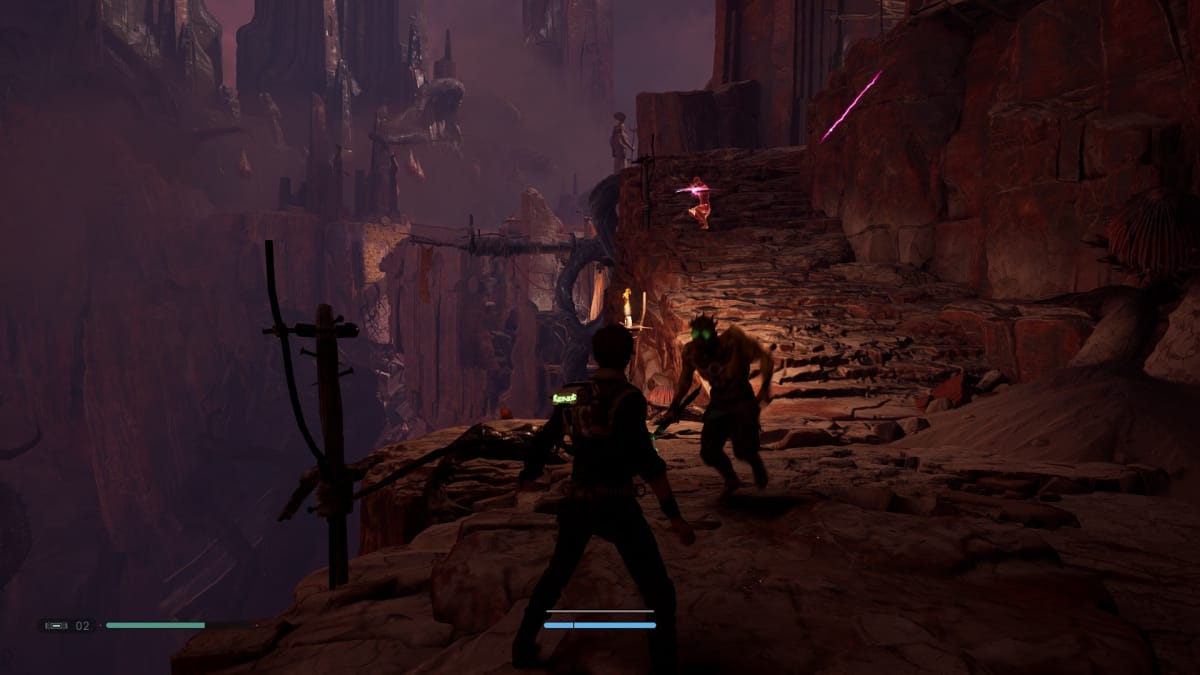In the wake of the PlayStation 5 outperforming the Xbox Series X across many next-gen games, Microsoft pulled the "most powerful console" tagline from its socials. Its on-paper specs haven't translated to real-world performance. However, legacy software reverses these power dynamics. Some may spell doom and gloom with how little Series X's extra teraflops have added to games. Doing so misunderstands the system's more significant technical advantage. Thanks to a more flexible back-end, older games are able to take better advantage of Microsoft's next-gen console than Sony's PS5, leading to more tangible wins. Let's take a look at how much more transformative last-gen games are on Series X than PS5.
Unpatched Legacy Software

While patched backwards-compatible games are where the more interesting differences lie, we'd be remiss not to mention the several hundreds of titles running on untouched last-gen code. The power differential between Xbox One X and PS4 Pro translates to typically better experiences on Series X than PS5.
For example, Final Fantasy 15 combines dynamic resolution scaling with checkerboard rendering for its PS4 Pro image output. Xbox One X still uses DRS, but with reconstruction ditched in favor of native rendering, image quality is much sharper. This is combined with a higher-resolution texture pack only otherwise available on PC, making it the definitive console version. Series X benefits from running at the upper bounds of the original's DRS. PS5 also runs at higher average resolutions than PS4 Pro, but those pixel counts are reached through checkerboard rendering, leading to a significantly softer image that's also utilizing lower-quality textures.
This was normal for eighth-gen games enhanced on the mid-gen refreshes. By virtue of this, most unpatched legacy software is inherently better on Xbox Series X. Addressing the earlier parts of the generation, the PS4 usurped Xbox One, routinely handing in higher resolutions. A game like Just Cause 3 ran at 900p on Xbox One and 1080p on PS4. This image output makes the PS5 version the better way to play. Eighth gen's early years grow more complex, however, as you consider both manufacturers' approach to backwards compatibility.
Microsoft has a dedicated backwards compatibility team whereas Sony doesn't. The team spent over 500,000 hours playing games across the Xbox family to identify potential compatibility issues. Series X runs at full GPU and CPU clock speeds while utilizing the older GCN architecture in backwards compatibility mode.
The PS5 has three profiles:
- Native Mode: Full GPU and CPU clocks under GCN architecture
- Pro Legacy Mode: Reverts to PS4 Pro speeds
- PS4 Legacy Mode: Reverts to launch PS4 speeds
This leaves players unaware as to whether their PS5 is actually making use of the horsepower on a title-by-title basis. In the process of testing PS5 backwards compatibility, Assassin's Creed Unity came up as one of the few offenders for Digital Foundry. Running off the unpatched disk, which launched with an uncapped frame rate, Series X locked to 60 fps while the PS5 is incapable of reaching that target. At its worst, one indoor area ran between 36-40 fps while Series X maintained a 60 fps lock. This inconsistency has lead to a community creating a website documenting how well or poorly games run on Sony's new hardware. Series X also forces 16x anisotropic filtering on older games, a driver-level feature PS5 lacks.
The SSD Anomaly

Microsoft's consistency in upholding the end-user experience across its back catalog extends to loading times. PS5's SSD is twice as fast as its competition on paper. Next-gen games don't showcase this differential, with one or two second disparities being the norm. Even Control, which used Kraken compression to shrink its file size by 42% over Series X, only loads a little over a second faster.
These inconsequential differences stand in stark contrast to last-gen loading times. In Digital Foundry's coverage, The Division 2 booted to the character creation screen in 17 seconds on PS5 and seven seconds on Series X. In another test loading the same area on all platforms, PS5 loaded the hub in 16 seconds while Series X did so within six seconds.
In Gamespot's comparison video, Final Fantasy 15 took 48 seconds to load in the save file from bootup on Series X. PS5 mustered the same scenario in one minute and 10 seconds. The differences start to pile once we examine performance and visuals for patched titles.
Patched Backwards-Compatible Games
In this context, patched title refers to a game that has received an update for the new platform while still running under the old SDK—the software development kit all developers use during the course of console game development. Think games like Star Wars Jedi: Fallen Order, Ghost Recon: Breakpoint, and Cyberpunk 2077. Need for Speed: Hot Pursuit Remastered is the outlier with major performance dips around certain stretches in one track, but most other patched games run and/or look better on Series X.

Destroy All Humans is the best example of Microsoft's cross-compatible SDK's paying dividends. Looking at the patch notes, patch 1.08 removed the 30 fps cap on PS4. This has benefits for PS5 as it'll run at a locked 60 fps, though it is still beholden to the PS4 Pro's original 1080p resolution. Examining the Xbox tweaks reveals separate changes for Xbox One X and Xbox Series X. Xbox One X, which already ran at 60 fps, got "improved details" while Series X received "improved resolution and details". While we don't know what "improved details" refers to, making a separate tweak to resolution for Series X highlights the ease of Microsoft's underlying codebase. This results in a game that runs at 1080p 60 fps on PS5 with a dynamic 1260p to 4K range on Series X, employing reconstruction when the image falls below 4K. This resolution gulf doesn't impact performance either.
Star Wars Jedi: Fallen Order is another interesting test case with Series X offering resolution and performance modes. PS5, though, only gets the performance mode. PS5 renders at a fixed 1200p. Series X's performance mode employs a DRS range from 1798x1008 to native 1440p. Both versions reconstruct up to 1440p. The Series X's lower bounds are a surprising revelation, but it can also render above PS5, putting them on equal footing. Series X's real win here comes in the form of player choice with its additional resolution mode. This mode uses a DRS range from 1584p to native 4K. Fallen Order reconstructs to 4K when rendering a sub-native resolution.
Mortal Shell: Enhanced Edition is treated as a native next-gen app with its trailer boasting 4K resolution, enhanced textures, and double the framerate. Even the Xbox file info lists the Enhanced Edition as running under the GDK app model with the Scarlett designation. By comparison, Fallen Order's file info states it's running under the XDK app model with the Durango designation. Scarlett and Durango are the codenames used for the Xbox Series X's and Xbox One's development kits, respectively. Under console type, Star Wars is "Xbox One Gen Nine Aware" as opposed to Mortal Shell's console type being "Xbox Gen Nine."
Why is it under this section, then? Mortal Shell: Enhanced Edition's resolution targets line up with their predecessors. On PS4 Pro, Mortal Shell ran at a dynamic 1200p to 1440p with temporal upsampling used when dropping under 1440p. PS5 runs at a fixed 1440p. Xbox One X ran at a dynamic 1440p to 1800p with temporal upsampling as a fallback. Xbox Series X utilizes this exact rendering setup, though it often renders at the upper limits of that DRS range, using the same temporal upsampling to 1800p when it falls below that figure. This split makes it difficult to believe much work was done under the hood outside of removing the framerate cap.
This conversion's barebones nature is the perfect example of how much more stable the overall user experience is on Series X. Whereas the PS5 provides excellent versions of native next-gen games, its backwards compatibility is wildly inconsistent, often leading to much greater disparities between the competitors than native next-gen titles.
The Power Non-Controversy
This isn't the end to the backwards compatibility story with countless games not discussed in the article such as Cyberpunk 2077, which uses higher settings on Series X. There's also a list of 120 fps-enabled games that don't have similar options on PS5 due to ease of implementation, Overwatch being the most recent entrant with a Series X patch offering three performance modes. As of the time of this writing, though, there is no PS5 iteration in sight. Microsoft came out of the gate with a confidence that was showed up by its competitor's real-world performance. That confidence shouldn't dissipate. With much better and more consistent backwards compatibility, the Series X still provides many great experiences.
Have a tip, or want to point out something we missed? Leave a Comment or e-mail us at tips@techraptor.net













